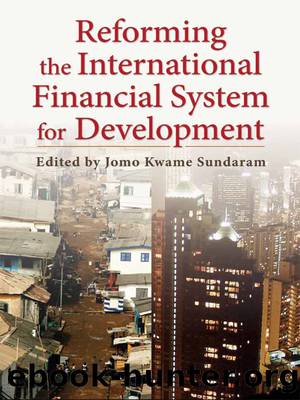Reforming the International Financial System for Development by Kwame Sundaram Jomo;

Author:Kwame Sundaram, Jomo;
Language: eng
Format: epub
Tags: Political Science/International Relations/General
Publisher: Columbia University Press
Published: 2011-10-31T00:00:00+00:00
7
* * *
The Basel 2 Agenda for 2009: Progress so far
Andrew Cornford
The revisions of Basel 2, the international standards for banksâ regulatory capital developed by the Basel Committee on Banking Supervision (BCBS) to replace the 1988 Basel Capital Accord (Basel 1), are now beginning to take shape. The 2006 text of Basel 2, which was the culmination of a drafting process which began at the end of the 1990s, had been considered closed before the credit crisis which began in mid-2007.1 This crisis has indicated major shortcomings in the regulatory framework for financial institutions which are now the subject of an agenda of wide-ranging reform.2 Strengthening Basel 2 is an important item on this reform agenda. (An outline of the Basel capital accords can be found in the Annex to this chapter.)
Two of the major subjects of the revisions of Basel 2, discussed in this chapter, are the rules for securitization exposures and the Market Risk Framework. These are covered by consultative documents issued by the Basel Committee on Banking Supervision in January 2009. The documents on the Market Risk Framework follow up earlier July 2008 consultative documents concerning the strengthening of the regulatory capital charges for the market risks of banksâ trading books. The new documents supplement the proposals of July 2008 with recommendations concerning the incorporation in the Framework of the proposed rules for banksâ securitization exposures whose strengthening is an important part of the Committeeâs response to the major part played by such exposures in the recent financial turmoil.
Other revisions of Basel 2 still to come include supplementing the risk-based minimum regulatory requirements of Basel 2 with simpler overall measures (such as banksâ aggregate leverage ratios) and the inclusion in the rules or guidelines for banksâ capital âadditional shock absorbersâ (such as through-the-cycle or countercyclical reserves) (Wellink, 2008).
Basel 2âs Rules on Securitization
Techniques of Securitization
The term âsecuritizationâ denotes one of a number of different financial operations involving the substitution of securities for other debt or the decomposition of large loans into loan shares or participations for distribution among financial institutions. The best known form of securitization consists of pooling loans and other debt obligations by banks and other financial institutions and the sale to investors of interests in the pool (asset-backed securities).
Investment instruments collateralized by pools of mortgage loans have a long history in the United States going back to the nineteenth century. In the 1980s the asset backing in securitization was extended to several other kinds of debt such as computer leases, automobile and truck loans, credit cards, trade receivables, junk bonds, and unsecured consumer loans. Initially, the mortgages in the pools of asset-backed securities were overwhelmingly prime, i.e. made to individuals with good credit histories. With the expansion of markets for assets with greater credit risk in the 1990s, the pools began to include sub-prime mortgages made to individuals with less highly rated credit histories. Initial development of markets for asset-backed securities took place mainly in the United States, but more recently, such markets have also taken off in other developed countries and in some emerging-market countries.
Download
This site does not store any files on its server. We only index and link to content provided by other sites. Please contact the content providers to delete copyright contents if any and email us, we'll remove relevant links or contents immediately.
| Accounting | Economics |
| Exports & Imports | Foreign Exchange |
| Global Marketing | Globalization |
| Islamic Banking & Finance |
50 Economics Classics by Tom Butler-Bowdon(2075)
Six Billion Shoppers by Porter Erisman(2007)
Why Nations Fail: The Origins of Power, Prosperity, and Poverty by Daron Acemoglu & James Robinson(1796)
No Time to Say Goodbye(1769)
The Economist [T6, 22 Thg9 2017] by The Economist(1654)
Red Notice by Bill Browder(1603)
Currency Trading For Dummies by Brian Dolan(1558)
Thank You for Being Late by Thomas L. Friedman(1461)
Bitcoin: The Ultimate Guide to the World of Bitcoin, Bitcoin Mining, Bitcoin Investing, Blockchain Technology, Cryptocurrency (2nd Edition) by Ikuya Takashima(1427)
Amazon FBA: Amazon FBA Blackbook: Everything You Need To Know to Start Your Amazon Business Empire (Amazon Empire, FBA Mastery) by John Fisher(1309)
The Great Economists by Linda Yueh(1191)
Coffee: From Bean to Barista by Robert W. Thurston(1188)
The Future Is Asian by Parag Khanna(1179)
Pocket World in Figures 2018 by The Economist(1159)
Capitalism Without Capital: The Rise of the Intangible Economy by Jonathan Haskel(1132)
Grave New World by Stephen D. King(1114)
How Money Got Free: Bitcoin and the Fight for the Future of Finance by Brian Patrick Eha(1113)
The Sex Business by Economist(1091)
Cultural Intelligence by David C. Thomas(1016)
